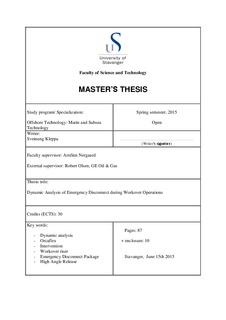| dc.contributor.author | Kleppa, Sveinung | |
| dc.date.accessioned | 2015-09-15T07:33:01Z | |
| dc.date.available | 2015-09-15T07:33:01Z | |
| dc.date.issued | 2015-06-15 | |
| dc.identifier.uri | http://hdl.handle.net/11250/299834 | |
| dc.description | Master's thesis in Offshore technology : subsea technology | nb_NO |
| dc.description.abstract | Emergency disconnect from the stack-up with large rig offset during well intervention is considered as a critical operation. Failure of disconnection from the well can lead to a major accident. Unofficial figures suggest that the connector fails to release 15 – 20 times globally each year. The industry has little detailed knowledge of the kinematics and trajectories of an emergency disconnect. GE Oil & Gas has shown interest of gaining more information regarding this matter. To comply with ISO 13628-7 the industry has developed High Angle Release (HAR) connectors for the Emergency Disconnect Package (EDP). The connector shall be able to safely release with a minimum offset angle of 10°.
The main objective of this thesis is to analyze the motions and the associated forces occurring immediately after disconnecting from the stack-up. To analyze the dynamics of the EDP after emergency disconnect Orcaflex was used. The established model in Orcaflex is verified by manual calculations and reasonable considerations. For better understanding of the dynamics involved, the Emergency Quick Disconnect (EQD) is analyzed with three different water depths and 15 Te overpull at the High Angle Release (HAR) connector.
The rig offset of 10° caused a bending moment of approximately 1000 kNm at the connector with the given riser configuration. The results showed that a large rotational motion dominated immediately after release. The EDP rotated with 12.6° within the first second after initiated EQD. Also an initial horizontal acceleration was found to occur simultaneously. The maximum initial horizontal acceleration was found to be approximately 4.7 m/s2. This led to a horizontal displacement of approximately 210 mm and a maximum velocity of 0.25 m/s. Several simulations with different EQD timing in waves were performed. This resulted in a minimum acceleration of approximately 6 m/s2 and a maximum acceleration of approximately 8 m/s2 in vertical direction depending on vessels position in the wave. | nb_NO |
| dc.language.iso | eng | nb_NO |
| dc.publisher | University of Stavanger, Norway | nb_NO |
| dc.relation.ispartofseries | Masteroppgave/UIS-TN-IKM/2015; | |
| dc.rights | Navngivelse-Ikkekommersiell-IngenBearbeidelse 3.0 Norge | * |
| dc.rights.uri | http://creativecommons.org/licenses/by-nc-nd/3.0/no/ | * |
| dc.subject | offshore technology | nb_NO |
| dc.subject | marine and subsea technology | nb_NO |
| dc.subject | high angle release | nb_NO |
| dc.subject | emergency disconnect package | nb_NO |
| dc.subject | workover riser | nb_NO |
| dc.subject | intervention | nb_NO |
| dc.subject | OrcaFlex | nb_NO |
| dc.subject | dynamic analysis | nb_NO |
| dc.subject | subsea | nb_NO |
| dc.subject | undervannsteknologi | nb_NO |
| dc.title | Dynamic analysis of emergency disconnect during workover operations | nb_NO |
| dc.type | Master thesis | nb_NO |
| dc.subject.nsi | VDP::Technology: 500::Marine technology: 580::Offshore technology: 581 | nb_NO |

